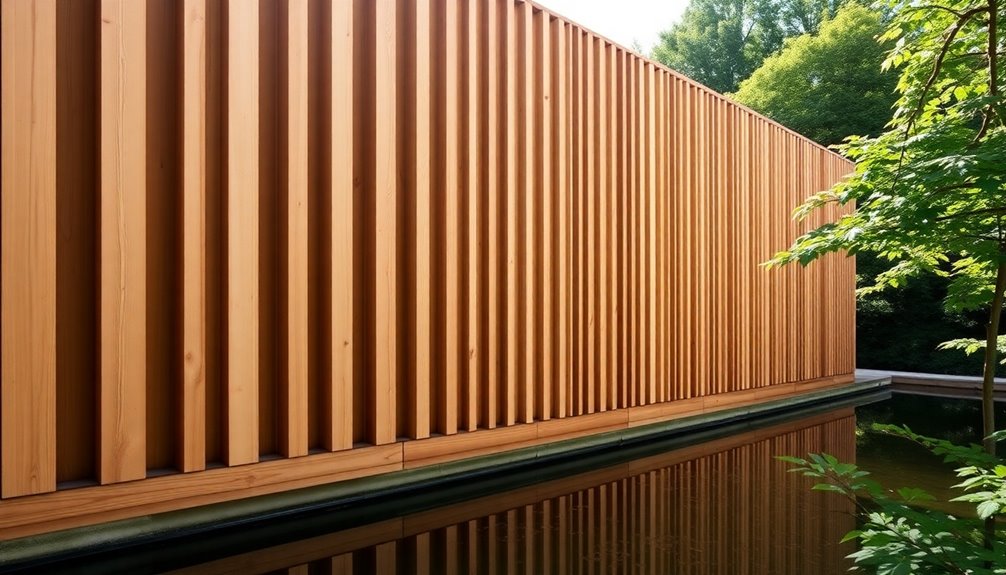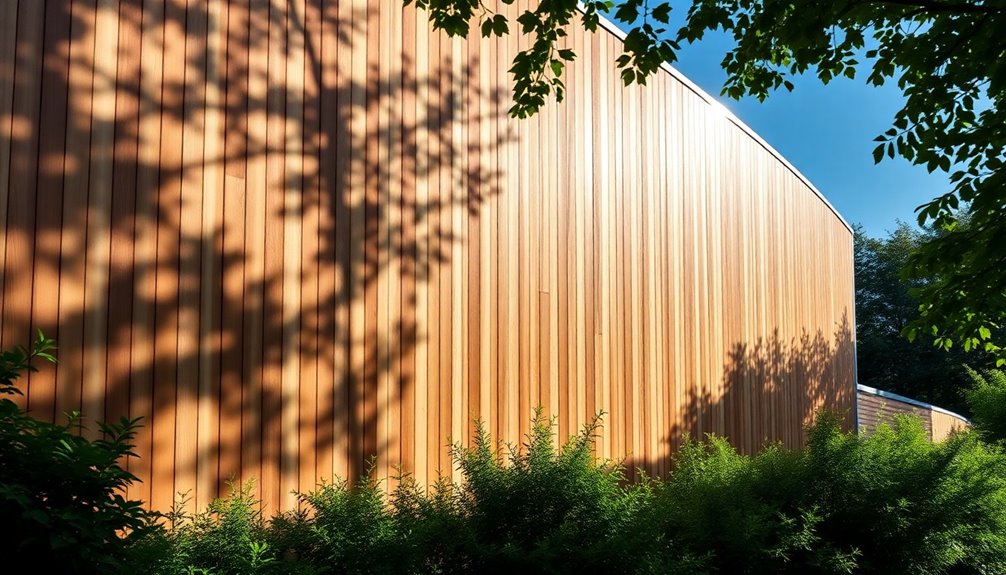Kew Pumping Station just got a chic facelift with elegant larch slats inspired by nature. This striking design enhances the station's visual appeal while supporting Kew Gardens' sustainability goals. The oval-shaped structure, built from natural European larch, fits perfectly into the landscape and boosts the garden's irrigation network. Plus, it showcases a commitment to environmental stewardship that anyone can appreciate. Stick around to discover more about the station's impact on Kew's heritage and innovation!
Key Takeaways
- The Kew Pumping Station features a chic design inspired by fallen leaves, enhancing its aesthetic with an oval-shaped plan and modular struts.
- Constructed from natural European larch, the building will develop a silver patina over time, blending with Kew Gardens' landscape.
- This renovation supports Kew's climate-positive goals by 2030, incorporating harvested rainwater for irrigation and reducing reliance on mains water.
- The pumping station serves as the core of Kew's irrigation network, ensuring efficient water distribution for the gardens' lush greenery.
- The design harmonizes innovative architecture with environmental stewardship, contributing to the historical narrative of Kew Gardens since the Victorian era.

The Kew Pumping Station has undergone an impressive facelift, transforming its design to reflect the beauty of nature while enhancing its functionality. Inspired by the delicate structures of fallen leaves and palm fronds, this architectural marvel showcases how innovation can harmonize with the environment.
You'll notice the natural European larch used in its construction, a material chosen for both its aesthetic appeal and durability, ensuring the building will age gracefully. As part of Kew Gardens' initiative to be climate-positive by 2030, this facility embodies the commitment to sustainable practices.
As you explore the new pumping station, you'll appreciate the sculptural quality of its oval-shaped plan, featuring interlocking modular struts. This design not only adds visual interest but also creates a sense of unity with Kew Gardens' rich landscape.
Over time, the larch will develop a silver patina, allowing the station to blend seamlessly with its surroundings, enhancing the overall experience of the gardens.
But it's not just about looks; the renovated pumping station plays a vital role in Kew's climate-conscious strategies. By reducing reliance on mains water, it supports sustainable practices through the incorporation of harvested rainwater.
You'll find that this system is crucial for watering the gardens, helping to preserve precious water resources while promoting environmental stewardship. Kew Gardens aims to be climate-positive by 2030, and this facility is a significant step toward achieving that goal.
Historically, Kew Gardens has always been a beacon of architectural excellence, with structures dating back to the Victorian era. The new pumping station adds to this legacy while differentiating itself from other sites, like the London Museum of Water and Steam, by focusing on modern irrigation.
It continues Kew's tradition of innovative engineering and architecture, integrating beautifully with existing features like the Treetop Walkway.
When you consider its operational functionality, the pumping station stands as the heart of Kew's irrigation network. It ensures reliable and efficient distribution of water stored in the underground tank, vital for maintaining the gardens' lush greenery.
With plans for future expansion, including more rainwater integration, you can expect this facility to evolve and adapt. Maintenance is simplified by the thoughtful design, making upkeep a breeze.
In essence, the Kew Pumping Station's chic facelift is more than just a visual upgrade; it represents a commitment to sustainability and a deep respect for the environment.
Frequently Asked Questions
What Is the History of Kew Pumping Station?
Kew Pumping Station, opened in 1838, was designed to improve London's water supply by extracting river water from the Thames.
Over the years, it expanded to include steam, diesel, and electric pumps. While steam engines were retired by 1944, many were preserved for a future museum, which opened later.
Today, you can explore this historic site, recognized for its significance in the water supply industry and its collection of original pumping engines.
Who Designed the New Larch Slat Facade?
Imagine stepping back in time, where architecture whispers tales of nature's beauty.
The new larch slat facade was designed by Hugh Broughton Architects. You'll find that their inspiration came from the vibrant plant life of Kew Gardens.
This innovative design choice not only enhances the aesthetic but also promotes environmental sustainability.
As you explore the area, you'll appreciate how the structure seamlessly integrates with its surroundings, reflecting both artistry and ecological consciousness.
How Long Did the Renovation Take?
The renovation took a few weeks during the summer.
You'd see the skilled installation happening by hand, which added to the project's unique charm.
As you walk around, you can appreciate how the design integrates with the environment.
The oval shape softens the structure's mass while providing functionality, creating a striking visual that enhances the beauty of the surrounding gardens.
It's a thoughtful addition to the landscape that you'll definitely notice.
What Materials Were Used in the Facelift?
Oh, you thought a facelift was just for people? Think again! The Kew Pumping Station got a stylish upgrade, using larch slats that scream "I'm sustainable and chic."
These natural beauties not only enhance aesthetics but also promise durability. Say goodbye to boring materials—larch is here to make a statement while respecting history.
Are There Tours Available for the Public?
Yes, there are tours available for the public at the Kew Bridge Steam Museum.
You can enjoy self-guided visits, allowing you to explore at your own pace with volunteers on hand for questions.
The museum also hosts special events, like the Giants of Steam weekend, where you can see large engines in action.
Plus, during summer, you can take a steam train ride around the site, making your visit even more exciting.
Conclusion
In reimagining the Kew Pumping Station with chic larch slats, you can see how design and functionality intertwine. This transformation isn't just about aesthetics; it challenges the theory that utility structures must remain purely utilitarian. By adding a stylish touch, the station becomes a community landmark, inviting curiosity and engagement. So, next time you visit, remember that beauty and purpose can coexist, making everyday spaces more inspiring and worth appreciating.









